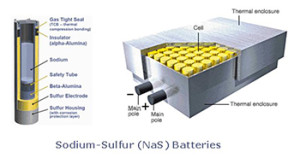Sodium sulfur battery is a standout amongst the most promising candidates for energy storage applications. Sodium Sulfur batteries or NaS batteries were initially created by the Ford Motor Company in the 1960s and later on sold to NGK, the Japanese Company. NGK now makes the battery system for stationary applications that work at very high temperatures of 300 to 350 OC.
Anatomy
As the name indicates, NaS battery has sodium (Na) as anode and sulfur (S) as cathode. The ceramic electrolyte is sodium beta alumina. For the battery to work, both the sulfur and the sodium must be in a liquid state and the electrolyte at a temperature in which it can act as an ionic conductor. Sulfur dissolves at 113 C and sodium at 98 C, yet the electrolyte does not work viably until the temperature reaches 350 C (also known as the battery’s working temperature). The cells are constructed as a pair of concentric tubes in which the internal tube made of the electrolyte holds one terminal while the external tube made of a metal, for example, aluminum, holds the other terminal. The cell is perfectly sealed, so that gases cannot leak.
During battery discharge, the electrons are stripped from the sodium molecules and while flowing from the sodium anode get attached to the sulfur cathode. The sodium ions (positively charged) travel through the electrolyte and react with the electrons and the sulfur to form sodium polysulphide. In contrast to this, during recharge, the connected voltage strips electrons from the sodium polysulphide transforming it back into sodium and sulfur ions.

Advantages
- High cycle life
- Potential low cost
- Flexible operation
- Good power density
- High energy efficiency
- State-of-charge identification
- Insensitivity to ambient conditions
Applications
- Aerospace
- Fork Lifts
- Electric Vehicles
Related Posts:
Alessandro Volta: Father of Modern Battery



